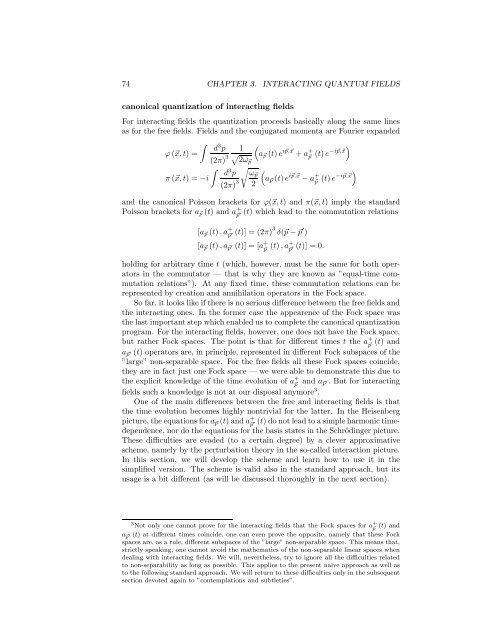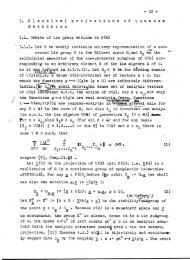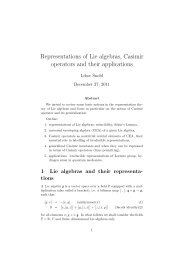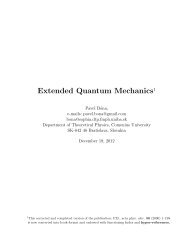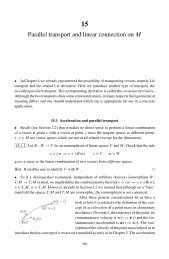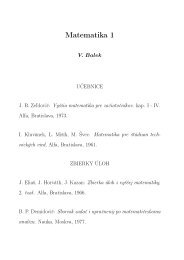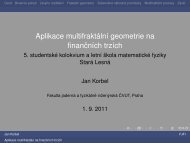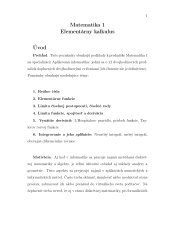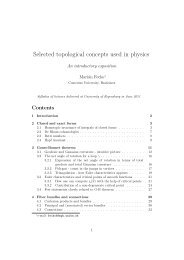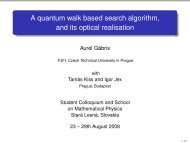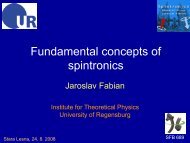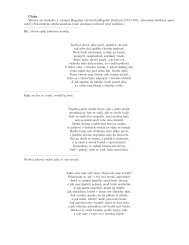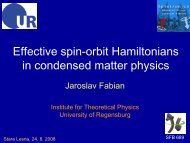Quantum Field Theory I
Quantum Field Theory I
Quantum Field Theory I
You also want an ePaper? Increase the reach of your titles
YUMPU automatically turns print PDFs into web optimized ePapers that Google loves.
74 CHAPTER 3. INTERACTING QUANTUM FIELDS<br />
canonical quantization of interacting fields<br />
For interacting fields the quantization proceeds basically along the same lines<br />
as for the free fields. <strong>Field</strong>s and the conjugated momenta are Fourier expanded<br />
∫<br />
d 3 p 1<br />
(<br />
ϕ(⃗x,t) =<br />
(2π) 3 √ a ⃗p (t)e i⃗p.⃗x +a + ⃗p (t)e−i⃗p.⃗x)<br />
2ω⃗p<br />
∫ √<br />
d 3 p ω⃗p<br />
π(⃗x,t) = −i<br />
(a<br />
(2π) 3 ⃗p (t)e i⃗p.⃗x −a + ⃗p<br />
2<br />
(t)e−i⃗p.⃗x)<br />
and the canonical Poisson brackets for ϕ(⃗x,t) and π(⃗x,t) imply the standard<br />
Poisson brackets for a ⃗p (t) and a + ⃗p ′ (t) which lead to the commutation relations<br />
[a ⃗p (t),a + ⃗p ′ (t)] = (2π) 3 δ(⃗p−⃗p ′ )<br />
[a ⃗p (t),a ⃗p ′ (t)] = [a + ⃗p (t),a+ ⃗p ′ (t)] = 0.<br />
holding for arbitrary time t (which, however, must be the same for both operators<br />
in the commutator — that is why they are known as ”equal-time commutation<br />
relations”). At any fixed time, these commutation relations can be<br />
represented by creation and annihilation operators in the Fock space.<br />
So far, it looks like if there is no serious difference between the free fields and<br />
the interacting ones. In the former case the appearence of the Fock space was<br />
the last important step which enabled us to complete the canonicalquantization<br />
program. For the interacting fields, however, one does not have the Fock space,<br />
but rather Fock spaces. The point is that for different times t the a + ⃗p<br />
(t) and<br />
a ⃗p ′ (t) operators are, in principle, represented in different Fock subspaces of the<br />
”large” non-separable space. For the free fields all these Fock spaces coincide,<br />
they are in fact just one Fock space — we were able to demonstrate this due to<br />
the explicit knowledge of the time evolution of a + ⃗p and a ⃗p ′. But for interacting<br />
fields such a knowledge is not at our disposal anymore 3 .<br />
One of the main differences between the free and interacting fields is that<br />
the time evolution becomes highly nontrivial for the latter. In the Heisenberg<br />
picture,theequationsfora ⃗p (t)anda + ⃗p<br />
(t)donotleadtoasimpleharmonictimedependence,<br />
nor do the equations for the basis states in the Schrödingerpicture.<br />
′<br />
These difficulties are evaded (to a certain degree) by a clever approximative<br />
scheme, namely by the perturbation theory in the so-called interaction picture.<br />
In this section, we will develop the scheme and learn how to use it in the<br />
simplified version. The scheme is valid also in the standard approach, but its<br />
usage is a bit different (as will be discussed thoroughly in the next section).<br />
3 Not only one cannot prove for the interacting fields that the Fock spaces for a + (t) and ⃗p<br />
a ⃗p ′ (t) at different times coincide, one can even prove the opposite, namely that these Fock<br />
spaces are, as a rule, different subspaces of the ”large” non-separable space. This means that,<br />
strictly speaking, one cannot avoid the mathematics of the non-separable linear spaces when<br />
dealing with interacting fields. We will, nevertheless, try to ignore all the difficulties related<br />
to non-separability as long as possible. This applies to the present naive approach as well as<br />
to the following standard approach. We will return to these difficulties only in the subsequent<br />
section devoted again to ”contemplations and subtleties”.


